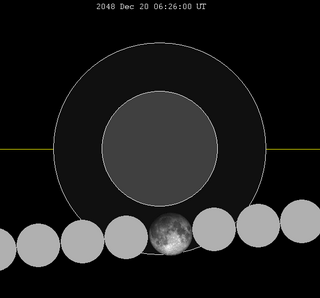
A total lunar eclipse will take place on July 7, 2047. It will last 1 hour 40 minutes and 49 seconds and will plunge the full Moon into deep darkness, as it passes right through the centre of the Earth's umbral shadow. While the visual effect of a total eclipse is variable, the Moon may be stained a deep orange or red colour at maximum eclipse. This will be a great spectacle for everyone who sees it. The partial eclipse will last for 3 hours and 39 minutes in total.
A penumbral lunar eclipse took place on Thursday, March 3, 1988, the first of two lunar eclipses in 1988, the second being on August 27, 1988. Earlier sources compute this as a 0.3% partial eclipse lasting under 14 minutes, and newest calculations list it as a penumbral eclipse that never enters the umbral shadow. In a rare total penumbral eclipse, the entire Moon was partially shaded by the Earth, and the shading across the Moon should have been quite visible at maximum eclipse. The penumbral phase lasted for 4 hours, 53 minutes and 50.6 seconds in all, though for most of it, the eclipse was extremely difficult or impossible to see. The Moon was 2.2 days after apogee, making it 6.1% smaller than average.
A penumbral lunar eclipse took place on Tuesday, January 20, 1981, the first of two lunar eclipses in 1981. In a rare total penumbral eclipse, the entire Moon was partially shaded by the Earth, and the shading across the Moon should have been quite visible at maximum eclipse. The penumbral phase lasted for 4 hours and 24 minutes in all, though for most of it, the eclipse was extremely difficult or impossible to see. The moon's apparent diameter was larger because the eclipse occurred 5.2 days after perigee.

A penumbral lunar eclipse took place on 10 January 2020. It was the first of four penumbral lunar eclipses in 2020. The moon’s apparent diameter was larger than average because occurred only 3 days before perigee and its distance was 375,887 km (233,565 mi).
A penumbral lunar eclipse took place at the Moon's descending node of the orbit on Tuesday, August 26, 1980, the last of three penumbral lunar eclipses in 1980 with a penumbral magnitude of 0.70891. This subtle penumbral eclipse may have been visible to a skilled observer at maximum eclipse. 70.891% of the Moon's disc was partially shaded by the Earth, which caused a gentle shadow gradient across its disc at maximum; the eclipse as a whole lasted 3 hours, 34 minutes and 26 seconds.

A partial lunar eclipse took place on Tuesday, November 29, 1955 with an umbral eclipse magnitude of 0.11899. A partial lunar eclipse happens when the Earth moves between the Sun and the Full Moon, but they are not precisely aligned. Only part of the Moon's visible surface moves into the dark part of the Earth's shadow. A partial lunar eclipse occurs when the Earth moves between the Sun and Moon but the three celestial bodies do not form a straight line in space. When that happens, a small part of the Moon's surface is covered by the darkest, central part of the Earth's shadow, called the umbra. The rest of the Moon is covered by the outer part of the Earth's shadow called the penumbra. It was the second of two lunar eclipses in 1955, first being the penumbral lunar eclipse on June 5. It also occurred near perigee, making such event a supermoon.

A penumbral lunar eclipse will take place on June 15, 2049.

A total lunar eclipse will take place on January 1, 2048. It will be the first recorded lunar eclipse to be visible on New Year's Day for nearly all of Earth's timezones. The next such eclipse will occur in 2094.

A partial lunar eclipse will take place on January 22, 2046.

A penumbral lunar eclipse will take place on March 3, 2045.

A total lunar eclipse will take place on September 19, 2043.

A total lunar eclipse will take place on September 7, 2044. It will be the first total eclipse in Lunar Saros 138.

A total lunar eclipse will take place on March 13, 2044.

A total lunar eclipse will take place on March 25, 2043.

A partial lunar eclipse will take place on July 18, 2046.

A penumbral lunar eclipse will take place on December 20, 2048.

A total lunar eclipse will take place on January 12, 2047.

A penumbral lunar eclipse will take place on May 17, 2049.

A total lunar eclipse will take place on April 26, 2051.

A total lunar eclipse will take place on October 30, 2050.
This page is based on this
Wikipedia article Text is available under the
CC BY-SA 4.0 license; additional terms may apply.
Images, videos and audio are available under their respective licenses.







































